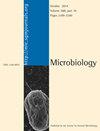Microbe Profile: Bacteriophage ϕ6: a model for segmented RNA viruses and the evolutionary consequences of viral 'sex'.
IF 2.6
4区 生物学
Q3 MICROBIOLOGY
引用次数: 0
Abstract
Bacteriophage ϕ6 is a segmented dsRNA virus with a lipid envelope, which are unusual traits in bacterial viruses but common in eukaryotic viruses. This uniqueness allowed ϕ6 and its Pseudomonad hosts to serve as a molecular model for RNA genetics, mutation, replication, packaging, and reassortment in both bacterial and eukaryotic viruses. However, an additional uniqueness of ϕ6, created by its high mutation rate, was its use as an experimental system to study key questions such as the evolution of sex (segment reassortment), host-pathogen interactions, mutational load, rates of adaptation, genetic and phenotypic complexity, and game theory.
微生物简介:噬菌体ϕ6:分段 RNA 病毒的模型和病毒 "性 "的进化后果。
噬菌体ϕ6是一种具有脂质包膜的分段dsRNA病毒,这在细菌病毒中并不常见,但在真核病毒中却很常见。这种独特性使ϕ6 及其假单胞菌宿主成为细菌和真核病毒中 RNA 遗传学、突变、复制、包装和重配的分子模型。然而,ϕ6的另一个独特之处在于它的高突变率,即它可以作为一个实验系统来研究一些关键问题,如性的进化(片段重配)、宿主与病原体的相互作用、突变负荷、适应率、遗传和表型复杂性以及博弈论。
本文章由计算机程序翻译,如有差异,请以英文原文为准。
求助全文
约1分钟内获得全文
求助全文
来源期刊

Microbiology-Sgm
生物-微生物学
CiteScore
4.60
自引率
7.10%
发文量
132
审稿时长
3.0 months
期刊介绍:
We publish high-quality original research on bacteria, fungi, protists, archaea, algae, parasites and other microscopic life forms.
Topics include but are not limited to:
Antimicrobials and antimicrobial resistance
Bacteriology and parasitology
Biochemistry and biophysics
Biofilms and biological systems
Biotechnology and bioremediation
Cell biology and signalling
Chemical biology
Cross-disciplinary work
Ecology and environmental microbiology
Food microbiology
Genetics
Host–microbe interactions
Microbial methods and techniques
Microscopy and imaging
Omics, including genomics, proteomics and metabolomics
Physiology and metabolism
Systems biology and synthetic biology
The microbiome.
 求助内容:
求助内容: 应助结果提醒方式:
应助结果提醒方式:


